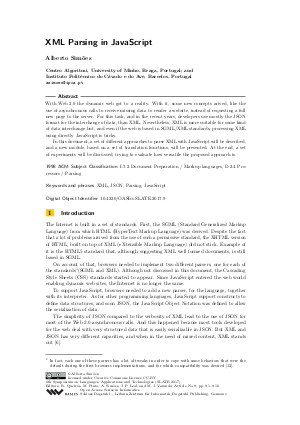XML Parsing in JavaScript
Author Alberto Simões
-
Part of:
Volume:
6th Symposium on Languages, Applications and Technologies (SLATE 2017)
Part of: Series: Open Access Series in Informatics (OASIcs)
Part of: Conference: Symposium on Languages, Applications and Technologies (SLATE) - License:
 Creative Commons Attribution 3.0 Unported license
Creative Commons Attribution 3.0 Unported license
- Publication Date: 2017-10-04
File

PDF
OASIcs.SLATE.2017.9.pdf
- Filesize: 427 kB
- 10 pages
Document Identifiers
Subject Classification
Keywords
- XML
- JSON
- Parsing
- JavaScript
Metrics
- Access Statistics
-
Total Accesses (updated on a weekly basis)
0Document
0Metadata
Abstract
With Web 2.0 the dynamic web got to a reality. With it, some new concepts arived, like the use of asynchronous calls to receive missing data to render a website, instead of requesting a full new page to the server. For this task, and in the recent years, developers use mostly the JSON format for the interchange of data, than XML. Nevertheless, XML is more suitable for some kind of data interchange but, and even if the web is based in SGML/XML standards, processing XML using directly JavaScript is tricky. In this document, a set of different approaches to parse XML with JavaScript will be described, and a new module, based on a set of translation functions, will be presented. At the end, a set of experiments will be discussed, trying to evaluate how versatile the proposed approach is.
Cite As Get BibTex
Alberto Simões. XML Parsing in JavaScript. In 6th Symposium on Languages, Applications and Technologies (SLATE 2017). Open Access Series in Informatics (OASIcs), Volume 56, pp. 9:1-9:10, Schloss Dagstuhl – Leibniz-Zentrum für Informatik (2017)
https://doi.org/10.4230/OASIcs.SLATE.2017.9
BibTex
@InProceedings{simoes:OASIcs.SLATE.2017.9,
author = {Sim\~{o}es, Alberto},
title = {{XML Parsing in JavaScript}},
booktitle = {6th Symposium on Languages, Applications and Technologies (SLATE 2017)},
pages = {9:1--9:10},
series = {Open Access Series in Informatics (OASIcs)},
ISBN = {978-3-95977-056-9},
ISSN = {2190-6807},
year = {2017},
volume = {56},
editor = {Queir\'{o}s, Ricardo and Pinto, M\'{a}rio and Sim\~{o}es, Alberto and Leal, Jos\'{e} Paulo and Varanda, Maria Jo\~{a}o},
publisher = {Schloss Dagstuhl -- Leibniz-Zentrum f{\"u}r Informatik},
address = {Dagstuhl, Germany},
URL = {https://drops.dagstuhl.de/entities/document/10.4230/OASIcs.SLATE.2017.9},
URN = {urn:nbn:de:0030-drops-79442},
doi = {10.4230/OASIcs.SLATE.2017.9},
annote = {Keywords: XML, JSON, Parsing, JavaScript}
}
Author Details
References
-
José João Almeida and José Carlos Ramalho. XML::DT a Perl Down-Translation module. In XML-Europe'99, Granada, Spain, May 1999.

-
Bear Bibeault and Yehuda Katz. jQuery in Action, Second Edition. Manning Publications, 2 edition, 2010.

- Bert Bos. Descriptions of all CSS specifications. Technical report, World Wide Web Consortium (w3c), 2017. URL: https://www.w3.org/Style/CSS/specs.en.html.
-
David Brownell. Processing XML Efficiently with Java. O'Reilly Media, 2002.

- James Clark. XSL Transformations (XSLT) - version 1.0. Technical report, World Wide Web Consortium (w3c), 1999. URL: https://www.w3.org/TR/xslt.
-
Rúben Fonseca and Alberto Simões. Alternativas ao XML: YAML e JSON. In José Carlos Ramalho, João Correia Lopes, and Luís Carríço, editors, XATA 2007 - 5th Conferência Nacional em XML, Aplicações e Tecnologias Associadas, pages 33-46, February 2007.

- Michael Kay. XSL Transformations (XSLT) - version 2.0. Technical report, World Wide Web Consortium (w3c), 2007. URL: https://www.w3.org/TR/xslt20/.
- Michael Kay. XSL Transformations (XSLT) - version 3.0. Technical report, World Wide Web Consortium (w3c), 2017. URL: https://www.w3.org/TR/xslt30/.
-
Peter-Paul Koch. The document object model: an introduction. Digital Web Magazine, May 2001.

- Travis Leithead. DOM parsing and serialization. Technical report, World Wide Web Consortium (w3c), 2016. URL: https://www.w3.org/TR/DOM-Parsing/.
-
Code Lindley. jQuery Succinctly. Syncfusion, 2012.

-
Mark Pilgrim. HTML5: Up and Running. O'Reilly Media, Inc., 1st edition, 2010.

-
Alberto Simões, Álvaro Iriarte, and José João Almeida. Dicionário-aberto – a source of resources for the portuguese language processing. Computational Processing of the Portuguese Language, Lecture Notes for Artificial Intelligence, 7243:121-127, April 2012.

